by Lev Cohen 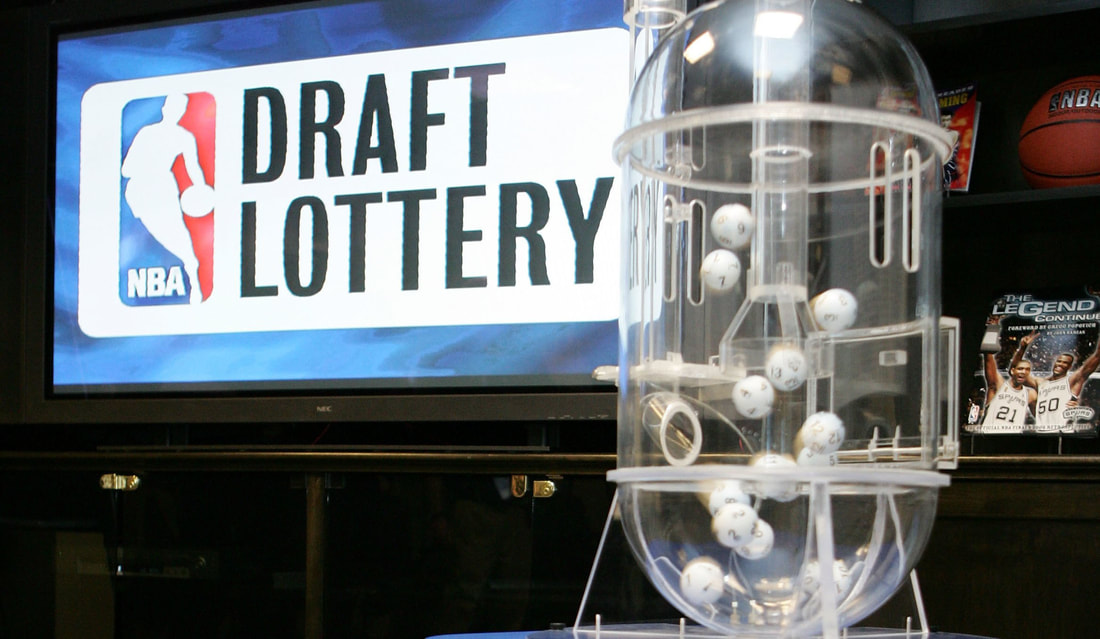 The NBA is a superstar-dominated league. Teams need at least one -- and usually two or three -- star players in order to compete for a championship. For most teams, the best way -- maybe even the only way -- to find a superstar player is through the NBA draft. And the best place to find potential franchise-changing players is at the top of the draft, where the best prospects are selected.The Problem: The draft order is roughly the inverse of the order that teams finished in the year before. The worse a team is, the better their draft pick is the following year. Due to (founded) fears that this system would incentivize losing, the NBA instituted a draft lottery, using combinations of ping pong balls to determine the draft order. 14 teams -- every team that did not make the playoffs -- are placed in the lottery. Under the current system, the team that finished with the worst record has a 25% chance of earning the first pick -- 25% of the winning ping pong ball combinations. The next-worst team has a 19.9% chance, followed by 15.6% and a steep decline all the way down to 0.5% for the best non-playoff team.The lottery is used to determine the first three draft slots. The 11 teams not in the top three draft in the inverse order of their finish the season before. This lottery was supposed to disincentivize teams from losing on purpose to improve their draft slot. It didn’t. The incentive to pick high in the draft -- and the fear of being stuck in mediocrity, too good to get a high draft pick but not good enough to contend for a championship -- is so strong that teams have intentionally gutted their teams (this is known as tanking) in order to be bad enough to “earn” better lottery odds.The most striking example of this came in Philadelphia, where the Sixers traded away their veteran players and intentionally lost games for four straight seasons in order to secure high draft picks. The problem for the NBA is that this strategy works. The Sixers ended up with two superstar players and have a future far brighter than they would have had if they had remained mired in mediocrity. The NBA, of course, does not like when its teams lose on purpose. So the league has investigated ways to disincentivize tanking, leading to a change passed by team owners before this season.
The NBA’s Solution: Starting in 2019, the three worst teams will have an equal 14% chance to win the first overall draft pick. The #1 pick odds will then go down smoothly -- by between 1% and 2% -- down to 0.5% for the best non-playoff team. Four teams will now be selected in the lottery instead of five. The goal of this change is obvious. The team with the top lottery odds will see their chances of picking first go down from 25% to 14% and in the top three from 64.3% to 40.1%. The teams helped most by the change are the ones in the middle of the lottery. The team in the eighth slot, for example, is more than twice as likely to get the top pick and 260% more likely to secure a top four pick.This change is an improvement, but it won’t come close to eradicating tanking. There will still be bad teams (winning, of course, is a zero-sum game). And because the lottery odds still favor the worst teams, those bad teams will still want to lose games in order to improve their lottery standing. In some cases, the tanking may even be worse. Teams that would otherwise be fighting for a playoff spot, for example, may glimpse the better odds given to mid-tier lottery teams and rest a player here and there. That will remain the case as long as the lottery order is the inverse of the season standings.Better solutions: There have been all kinds of proposals about how to replace the draft lottery. Some, arguing that the draft itself is flawed and that draft prospects should be able to pick their teams, believe that the draft itself should be eliminated and players should go straight to free agency. Others want to give the best teams the best picks in order to fully incentivize winning or to totally randomize the order by giving each team an equal chance to secure every draft pick.The most innovative, albeit flawed, proposal is the wheel. Initially proposed by Mike Zarren, Assistant General Manager of the Boston Celtics, the draft order would be set for 30 years. Each team would cycle through every pick in the draft, and each six year set of picks would have roughly the same overall value. The team awarded the first pick, for example, would then receive the 30th, 19th, 18th, 7th, and 6th picks in the next five years. The team with the second pick would be looking at a run of the 29th, 20th, and 17th picks in the following three years. This ensures that no team would have a run of top picks followed by a bunch of lower picks.This proposal has major flaws. A bad team could be faced with a run of three straight late first round picks, potentially setting that team up for a long stretch of hopeless play and robbing the fandom of any hope. On the other hand, a very good team could have the chance to add a generational talent if it had the fortune of getting a top pick at the perfect time. And because the draft order would be set years in advance, elite prospects could time their entries to the NBA draft in order to guarantee selection by a team in a better situation. This could add to the league’s competitive imbalance.But the wheel system has its virtues. It would eliminate tanking, simplify future draft pick trading, and make the league more competitive. Zarren found that the best solution could be to marry the wheel proposal and the current lottery system.The Wheel Lottery: When his initial wheel proposal was met with pushback, Zarren submitted two additional systems. The first would reduce the 30 year cycle to 10 years, and the other would push it down to five years. The following proposal would incorporate parts of each plan and reduce the original 30 year wheel proposal made by Mike Zarren to a six year cycle.Rather than assigning each team every draft pick, the teams would be sorted randomly into six different groups of five teams. Those five teams would cycle through six draft areas in the six year cycle. Those areas would be each group of five picks: 1-5; 6-10; 11-15; 16-20; 21-25; 26-30. In any given year, the top five picks would be composed of one of the six groups of five teams. Like with Zarren’s original proposal, the groupings would be determined in advance so that teams would know roughly where they would be drafting for the next six years. Each team would be guaranteed a top-five pick every six years and a top-10 pick every three years. A lottery would determine where exactly in these ranges each team would draft. The lottery would be similar to the current one in that it would be based on performance the previous season. The worst team in the five team grouping would have the best chance to get the top pick within that grouping, and the odds would gradually decline to the team with the best record in the grouping. This could give hope to bad teams without being enough to incentivize losing. Bad teams would have an increased chance of winning the first pick every six years with the knowledge that they would be guaranteed a top-five pick even if they were to sign a bunch of veteran players and improve. Great teams, meanwhile, would have a smaller chance to win the top pick, thus increasing the level of competition in the league. This proposal would provide a safety net for teams, allowing them to strive to be as good as possible and removing the fear of being stuck in the middle. The range of potential outcomes would be small enough to keep teams from tanking. There would no longer be an incentive to miss the playoffs, because every team would be a “lottery” team.
by Anthony Ramicone In the world of American professional sports, the NFL’s post-season format is one of a kind. While the other members of the “Big Four” (NBA, MLB, and NHL) all use best-of-x series to decide who advances in the post-season, with the exception of Major League Baseball’s wildcard games, the NFL uses single games to determine which team will advance.
Yet, as most learn in Statistics 101, a smaller sample size will lead to more random outcomes. The other leagues’ five and seven game series at each step of the process force teams through a post-season gauntlet. The rigor of these drawn out post-seasons goes a long way to minimizing randomness, which is likely why a seed higher than three has only won the NBA Finals twice in the league’s history. But in the NFL, where the phrase “any given Sunday” stands as a testament to the randomness of any single game, no such barriers exist. This leads to results such as Super Bowl XLVI, in which the Green Bay Packers, who held the league’s 10th best record, were crowned league champions.
In an attempt to mitigate the impact of this randomness, the NFL awards byes to the best two teams in each conference, requiring them to win three games rather than four in order to be crowned champions. However, this precaution is not enough. In the 24 editions of the NFL Playoffs since the field was expanded to 12 teams, a team seeded higher than two has won the Super Bowl eight times. It is important to note that there is a team for each seed from each of the two conferences, so on eight occasions, a team presumably outside of the top four regular-season performers has been crowned champion.
The rationale behind the single-game system is simple: the players’ bodies can only handle so many games. In a league where a complete season consists of 16 games, even utilizing a best-of-three game series format in the post-season seems unreasonable. The NFL has considered expanding its regular season schedule from 16 to 18 games, and there has been considerable push-back from the players union. Thus, it seems that a significantly expanded post-season is off the table.
There is, however, another option. In Australian sports leagues, including the National Rugby League and the Australian Rules Football League, the post-season is conducted using what is known as a McIntyre System. In a McIntyre Playoff, the best teams face off earlier in the competition than they normally would, but are rewarded by not facing immediate elimination. An example of the McIntyre system applied to the NFC-portion of the NFL Playoffs is shown below (winners are listed in bold).
As seen in this example, the Wildcard Playoffs go on as they normally would. In the Divisional Playoffs, however, the 1 and 2 seeds, in this case Seattle and San Francisco, play each other. This is different from the current method, in which Seattle would face the highest remaining seed. Much like the current system, the winner of Seattle/San Francisco advances to the Conference Championship. However, and this is the key difference, the loser is not eliminated. San Francisco plays the winner of the four-team playoff that began during the Wildcard round (Philadelphia), and the winner of that matchup also moves on to the Conference Championship.
This system ensures that either the 1 or 2 seed in each conference is guaranteed to play in the Conference Championship. Furthermore, the losing team has a second chance to qualify for the Conference Championship. This playoff structure rewards those who perform well during the regular-season more generously and, by increasing the rigor of the post-season, reduces the likelihood of mediocre teams being crowned NFL Champions.
The system would also benefit the league financially. By inserting an extra week into the post-season that includes two games, the NFL will have an increased amount of content, allowing it to negotiate more lucrative television deals. This extends the NFL season during its most profitable time without watering-down the quality of the playoffs by adding more teams or increasing the number of games for the vast majority of players. By switching to a McIntyre playoff, the NFL could increase revenue and ensure a more deserving champion, killing two birds with one stone.
by Anthony Ramicone The 2014 FIFA World Cup is upon us. The competition begins today in Brazil and will capture the world’s attention for an entire month. The field is set, and of the 32 nations competing, five are African. Algeria, Cameroon, Ghana, Ivory Coast, and Nigeria, who have all made World Cup appearances before, will be vying for the title once again.
But what are their chances of winning? In short, terrible. The sports books have deemed Ivory Coast to have the best odds at 125/1, and Algeria face some of the longest odds in the tournament at 1500/1. These long odds are nothing new: an African team has never advanced past the quarter-finals.
This seems odd, since there are plenty of Africans playing soccer at the highest levels. For instance, the 25 best clubs in Europe (according to UEFA’s Club Coefficient) have 43 African players, whose nationalities are concentrated to a handful of countries. Yet there are a variety of reasons why African nations have fared poorly in World Cup showings, including poor youth development and unpopular domestic leagues, among other things. However, most of these problems require a great deal of time and even more money to fix. That said, there is one thing that CAF (Africa’s soccer confederation) could do to almost immediately improve its members’ future World Cup chances: change the qualifying format.
For the current World Cup cycle, CAF has been awarded 5 spots. How CAF decides to allocate these spots, however, is left completely up to them. Here is what CAF decided to do:
· Sort member nations according to their FIFA Ranking from 1 to 52. Award nations 1-28 a bye to the second round.
· First Round: Pair off nations 29-52 into 12 fixtures, which are to be decided in a two-game aggregate series. Winners advance to the second round.
· Second Round: Place 28 nations with byes and 12 round one winners into 10 groups of four nations each, taking FIFA ranking into account. Each group is a double round-robin. Winner of each group advances to third round.
· Third Round: Taking FIFA ranking into account, pair off 10 group winners into five fixtures. Which are to be decided in a two-game aggregate series. Five winners qualify for World Cup.
While exciting, this is not a system that is meant to ensure that the five best nations qualify for the World Cup. Almost every other continental confederation uses a more forgiving system, in which group stages, not two-game playoffs decide the final qualifiers, and rarely must a nation win a group outright to advance.
Unlike in other confederations, CAF qualifying is high stakes at every stage. In the second round, only one team from each group advances, so one slip up can end a nation’s world cup hosts. And the third round is even riskier, with the opponent you draw being of the utmost importance.
Granted, CAF’s qualifying system makes sense if two statements hold true:
1. FIFA Rankings are meaningful, and
2. Soccer is a game in which the better team almost always wins, i.e. there is little randomness
Unfortunately, neither of these claims hold up under much scrutiny. FIFA Rankings serve as vague barometers of a nation’s ability, but nations have far too few common opponents or competitive matches in general for the ranking to have any kind of precise predictive power. Soccer is also a sport with a great deal of randomness. This is why top European leagues, such as the English Premier League or the Spanish La Liga crown champions only after clubs have played 38 games, giving the title to the team with the best overall record. It takes time to separate the best from the rest, so placing teams such as Cameroon (ranked 50th worldwide), Algeria (52), and Tunisia (55) into small groups with Gabon (60), Libya (T-63), and Morocco (T-63) and only allowing one team to advance seems like a foolish way to try to determine the highest quality nations.
A lower stakes model with two group stages, like the one used by in Asian qualifying, would provide a decent solution. For example, the first couple of rounds could use two-game series to whittle the competition down to 24 nations (there are far fewer than 24 legitimate contenders for the final spots, so giving the 16 highest-ranked teams byes and letting the rest fight it out is a low-risk solution that makes things quick). Separate the 24 remaining countries into four groups of six teams each. Advance two teams from each group, and in the final round, split the 8 remaining nations into two groups of four, with two nations from each group qualifying for the World Cup. The fifth spot would go to the winner of a play-off between the third-place team from each group.
This scenario allows the top teams to play more games, allowing a higher margin for error. One bad day from a star striker or one single howler from a keeper will not eliminate a team from contention like it would in the current system. If CAF wants its nations to succeed at the World Cup, it needs to ensure that it is sending its best possible squads. Changing how those squads are selected is a good first step.
By Devin McCarthy Last week was baseball's annual Hall of Fame selection, which makes it a good time to revisit Fair Sports Rules' Hall of Fame voting reform suggestions from a year ago. At the time, I concluded that the Hall's approval voting method of election is probably the best option for determining who gets inducted. That might come as a surprise to anyone who has followed Fair Sports Rules and its parent organization FairVote, since we generally argue that ranked choice voting is a superior system in almost all types of elections. The reason approval voting seems to make so much sense in this case is that Hall of Fame voting is essentially a question of approval. A voter has to decide whether he or she "approves" of a given player as Hall-worthy, and approving of one player doesn't really hurt the chances of another player getting elected. While we have suggested that ranked choice voting as a good idea for several sports-related elections, including baseball MVP voting, I restrained my Hall of Fame reform recommendations to relatively modest changes like lowering the threshold for staying on the ballot in future elections and removing the ten player limit for each ballot. Nonetheless, we were pleased to see a few commentators this year suggesting a ranked choice voting system for Hall of Fame voting. Those included Tom Tango, author of the well-regarded sabermetrics book "The Book," and Geoff Buchan of RotoValue.com. Tango's proposal works like this: every voter would rank ten players, as they currently have the option (but not the requirement) to do. However, voters would also have the ability to draw a line somewhere on that list of ten, to indicate which voters they actually think deserve to make it to the Hall. For instance, a voter could draw a line below their fourth-ranked player, indicating that he or she thinks four players are deserving of Hall spots. The first round of tabulating would function as now - players who were placed above the line by more than 75% of voters would be elected. After that, any ballots remaining with players above the line would have their votes count toward the player ranked one below their lines. Any ballots still remaining would transfer down to the next line, and so on. It's an interesting idea, and one that would almost certainly avoid scenarios like the 2013 election where no players were inducted to the Hall. There are some potential problems with the proposal, however, that differentiate it from the ranked choice voting systems we typically support. Most importantly, there would be plenty of opportunities under this system for voters to vote strategically, both in the order of their rankings and in the placement of the lines. To give just one example: a voter who really did not want a player to get elected would leave the player off the ballot completely, even if he or she thought that the player was the fourth most deserving player but definitely not deserving enough. Another issue is that it would be a common occurrence for voters' ballots to end up helping to elect players who they don't actually think should be elected. I would imagine a lot of dissatisfaction on the part of voters about that feature of the system. For those who want to keep the Hall of Fame a very exclusive institution, this system would also significantly increase the number of players elected each year. The flaws in Tango's system do not mean we should completely discard ranked choice voting as an option for Hall of Fame voting. An alternative system would be to simply elect a constant number of players to the Hall each year - say, three per election - and determine those players using the multi-seat form of ranked choice voting (also known as the single transferable vote). Under this system, voters could rank as many or as few players as they want. This would remove all incentives for strategic voting, maintain the quality of players in the Hall, and not force voters to help elect players they do not think are deserving, while still allowing voters to express their full preferences and preventing inductee-less years like 2013. The 2014 Hall election was another controversial one, with one voter barred for life from Hall voting for giving up his ballot to internet voters in protest of the broken process. The Baseball Writers Association of America has the power to propose changes to the voting system. They should absolutely be considering whether a ranked choice option might be the best way to go.
There’s something wrong with a voting system where a majority of voters can vote for a candidate, and he can still lose.
By Devin McCarthy and Matt Dewilde  Cabrera vs. Trout / ESPN Major League Baseball decides its MVP using a ranked-choice system, of sorts. It is a point-based system known as a “Borda count” – a method already discussed on this blog in the context of FIFA Ballon D’Or voting. It’s a pretty good voting system for baseball, as it allows voters to fully express their MVP preferences without any fear of vote splitting or wasting a vote on a “spoiler” player. In the MVP Borda count, each voter receives ten votes. A first place vote gives a player 14 points, a second place vote gives 9 points, a third place vote 8, and so on, down to one point for a tenth place vote. The effectiveness of the Borda count is predicated on voters being honest on their ballots. The system is very susceptible to strategic voting, as a voter with a strong preference that one player win the MVP over another serious contender could rank his or her favorite player first and not rank the second at all, so that he receives zero points. Fortunately, the members of the Baseball Writers’ Association of America have very little reason to be dishonest in their voting. MVP voting is not an election of a player to an office, but rather an evaluation of his performance in the past year. The results of the election have no effect on the voter. Baseball players also do not have political parties, so voters do not have an incentive to boost the vote totals of one party at the expense of another. Most importantly, MVP ballots are public, not secret, and there are only 30 total voters. If a voter casts an absurd ballot that leaves off an obviously great player, there’s a good chance that ballot will be noticed and thoroughly mocked on the internet. Polarized MVP Voting Nonetheless, there have been indications of some factionalism emerging among MVP voters. Two relatively distinct “parties” have developed: voters who prefer to use traditional measures of player value, like batting average, RBIs, and the success of the player’s team, and voters whose decisions are based on more recently developed “sabermetric” measures of value, such as WAR (wins above replacement). The MVP award has become a focal point of the debate over how big a role sabermetrics – that is, advanced statistical methods of interpreting baseball – should play in evaluating the quality of players. During the 2012 season, Miguel Cabrera made baseball history by becoming the first player to win the Triple Crown (leading the league in the traditional measures of batting average, home runs, and runs batted in) since 1967. In the very recent past, a Triple Crown winner would have been a unanimous choice for MVP. But sabermetrics have become increasingly popular among some Hall voters, and these metrics – which better account for things like speed and defense – strongly suggested that Mike Trout was more valuable than Miguel Cabrera in 2012. Cabrera still won the MVP in 2012 with a large majority, garnering 22 first place votes to Trout’s six. There was no evidence of either “sabermetrician” or “traditionalist” voters attempting to sabotage the other side’s candidate by ranking him low or leaving him off the ballot entirely – all voters ranked both Trout and Cabrera either first or second except one, who ranked Trout third behind Adrian Beltre. MVP voters were given a nearly identical question this past year, after Cabrera and Trout once again dominated the league. Cabrera didn’t win the Triple Crown in 2013, but was actually a better offensive performer than in 2012. Trout had another stellar year, and while his defense slipped slightly from his extraordinary rookie year, most sabermetric measures again showed Trout to be the most valuable player. Unsurprisingly, Cabrera won again, with 23 first place votes compared to just five for Trout. This time, the voting was less straightforward; while every voter ranked Cabrera first or second, there were ballots that ranked Trout fourth, fifth, and seventh. Borda Count Breakdown The man who ranked Trout seventh, Bill Ballou, explained himself by arguing that no player on a team that doesn’t contend for the playoffs has any value, and Trout’s Angels were a last-place team in 2013. His argument was somewhat undermined by the fact that he ranked David Ortiz, a member of the World Series-winning Red Sox, below Trout; if he had fully followed through on that principle, he would not have ranked Trout at all. The other voters who ranked Trout so low likely had similar rationales. Even if these voters were not strategically ranking Trout lower to increase the chances that Cabrera would win, it is problematic that a player’s point total could be significantly hurt because a small group of voters believe that the definition of the award disqualifies the player from contention. In a Borda count system, ranking one of the two main contenders very low will hurt him much more than simply not voting for him in a plurality system. In fact, a Borda count system gives a rogue voter almost three times as much power to influence the outcome as a “normal” voter who ranks the two main candidates first and second. That’s because the normal voter could only create a 5 point swing between Cabrera and Trout (giving one player 14 points and the other 9). But a “rogue” voter – one who is either strategically voting to help one of the two candidates win or believes that one of the two does not qualify as “valuable” at all – could create a 14 point swing (giving one player 14 points and the other 0). Thus, the system gives disproportionate power to voters who are either dishonest or crazy. Obviously, Miguel Cabrera would have won the 2012 and 2013 MVP awards regardless of what voting system was used. But in a closer race, the use of Borda count could absolutely have made the difference. Here's a hypothetical example in which the Borda count system would be a problem, sticking with the Cabrera/Trout debate. Let’s say that of 30 voters, 16 of them ranked Trout first, and all 16 of those voters ranked Cabrera second. That’s a total of 224 points from first place votes for Trout. Meanwhile, 14 voters ranked Cabrera first, giving him 196 points from first place votes. Two of those 14 writers, however, decided that Trout was ineligible for the award because the Angels were not in playoff contention, and did not rank him at all. The other 12 ranked Trout second. Trout would then get 108 points from his second place rankings, while Cabrera would get 144 from his. Add that all up, and Miguel Cabrera has defeated Mike Trout 340 to 326, even though a majority of voters thought Trout was the Most Valuable Player. It’s an unlikely scenario, but not an implausible one. In fact, it very nearly occurred in 2006, when Justin Morneau defeated Derek Jeter by a slim 14 point margin for the AL MVP, in part because Joe Cowley ranked Jeter sixth. Cowley’s logic: Jeter could not be the most valuable because the Yankees had several other good players that year. The Change: Ranked Choice Voting There’s a way to address this problem without changing the MVP ballot: ranked choice voting. Instead of a point-based preference system, ranked choice voting determines the player with majority support by transferring votes from defeated players to their voters’ second choices. The player with the fewest first choice rankings is eliminated first, and transfers continue until one player has a majority of votes. In the hypothetical example above, Mike Trout would have won outright without any transfers due to his majority of first choice votes. In a race with more than two serious candidates – say, the 2011 AL MVP race, where Justin Verlander received only a plurality of first choice votes – some voters’ ballots would be transferred to their second choices, in that case starting with the lone voter who ranked Michael Young first. Ranked choice voting maintains all the advantages of the Borda count – allowing voters to express their full preferences and eliminating spoilers and vote-splitting issues – without giving voters the temptation of dishonest strategic voting or the ability to distort the election result with outlying interpretations of the definition of “valuable.” Of course, baseball’s MVP is far from the institution most in need of ranked choice voting – that’d be the House of Representatives. The Borda count method has never been a real problem for baseball, only a potential one. Still, the example of the Cabrera/Trout MVP battle is instructive for why a Borda count (and other systems that give voters incentives to dishonestly hurt a candidate, such as Range Voting) might be a bad idea for political elections. In an election with secret ballots in which voters actually have a vested interest in the outcome, there would be a lot more strategic voting. It’s hard to imagine too many Obama voters giving Romney nine points when they could give him zero, and vice versa. So, should baseball change its MVP voting system? It’s well worth thinking about.
By Andrew Douglas 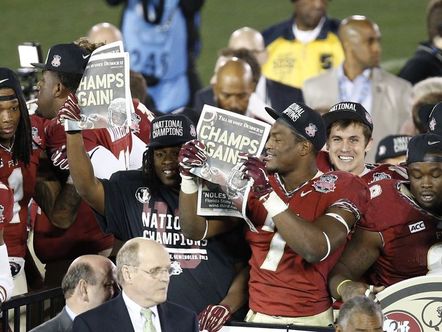 Florida State players celebrating victory in the last ever BCS National Championship Game / Kelvin Kuo-USA TODAY Last night’s BCS title game marked the end of a chapter of college football history that has been defined by annual controversies surrounding the complex and opaque system used to decide which teams will play for the national championship. The four-team playoff that will replace the BCS system next year is a clear improvement over the current system. But with so few teams involved and a selection committee choosing the participants through a process that remains uncertain, few fans will see it as a true solution to the problem of finding a fair method for crowning the sport’s champion. Our alternative proposal would expand this playoff to 16 teams, and ensure that they are chosen through the fairest and most transparent means available. Even a flawed four-team playoff will come as a relief to fans weary of the steady stream of debates and controversies spawned by the BCS. Such disputes were inevitable under a system in which just two teams would be selected through a process based in murky computer algorithms in addition to human polls. The most controversial moment for the BCS came at the end of the 2003 season, when AP voters ranked USC #1 in the season’s final poll, after the BCS had selected LSU and Oklahoma to play in the National Championship Game. That season’s split championship led to adjustments in the BCS formula, with the weight of the computer averages decreased, but controversy persisted. The very next season, five teams finished the season undefeated, with SEC champion Auburn, Utah, and Boise State left out of a championship game that featured Oklahoma and USC. Even this year, in the final incarnation of the BCS, there were four undefeated teams with three weeks remaining in the regular season, though late season upsets for two of these teams meant controversy around yesterday’s championship game was ultimately avoided. The four-team playoff that will replace the BCS system next season is a step in the right direction, but falls far short of creating a truly fair structure. With just four teams participating, controversies about deserving teams who have been left out are sure to persist, with undefeated mid-major schools and one-loss teams from major conferences likely to miss the playoffs in many seasons. Additionally, these teams will be selected by a small committee, through a process that remains unclear, and one which will not involve the ballots of individual committee members being made public. The small size of the playoff and the lack of transparency in the committee’s selection process are sure to result in further controversy surrounding college football’s bowl season. A better solution is to expand the playoff field and choose the participants through the fairest and most transparent means possible. Fair Sports Rules’ plan calls for the expansion of the field to 16 teams. As in the NCAA basketball tournaments, winners of each conference would receive an automatic berth. The remaining five at-large teams would be chosen by 100 of the nation’s top football analysts, writers, and former coaches using a proportional voting method called ranked ranked choice voting (also known as the Single Transferable Vote). Ranked choice voting is a fair election system used in countries like Australia, Northern Ireland, New Zealand, and Scotland, and U.S. cities like Minneapolis and Cambridge, Massachusetts. It has also been used since the 1930s to select nominees for The Oscars. A four-round playoff tournament between these 16 teams would bring an unprecedented level of excitement to college football, creating a period of “December Delirium,” comparable to college basketball’s “March Madness.” While the new college football playoff is set to be in place through 2025, hopefully it can be refined in response to inevitable controversies as the BCS was. Implementation of a plan like the one we have outlined would go much further to please fans, quell controversy, and ensure that college football’s national champion is chosen through the fairest method possible.
By Devin McCarthy 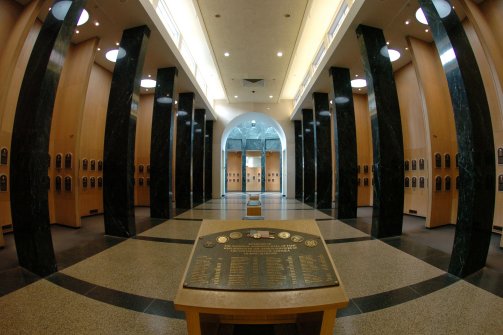 An empty Hall / Getty Images The 2013 Hall of Fame balloting has come and gone, and despite an excellent crop of eligible candidates with somewhere between 9 and 13 statistically qualified players, not a single one received enough votes for election to the Hall. The median voter thought seven players should be inducted this July. But no player received more than the 75% of the vote necessary for election. Many prominent baseball writers have understandably drawn attention to the voting rules as one of the culprits for the general unpleasantness and unproductive result of the 2013 balloting. One, Dave Studeman of Hardball Times, has started a petition to reform the Hall of Fame voting procedures, without asking for any specific changes. Before I discuss what aspects of Hall of Fame voting should be changed—and there are certainly are some—I’ll first start with what the current system gets right. The Hall of Fame uses approval voting with a very high threshold for election. That means, in effect, that on a Hall of Fame ballot voters either approve or disapprove of each candidate’s fitness for induction to the Hall. Approval voting is probably the most appropriate system for an institution like the Hall, in which there is no limit to membership and players are judged simply on whether or not they surpass a certain standard, albeit one that is very subjective on the part of each voter. Players are not necessarily racing against each other in a Hall of Fame election. A high threshold also seems appropriate, as there should be a general consensus on whether a player is deserving of induction before they are permanently enshrined in baseball’s pantheon. The 15 year period in which players are allowed to remain on the ballot is another reasonable rule, as it allows the conventional wisdom on players to evolve as more analysis is done on their careers and ensures that there will be some turnover in the voting pool while the player is on the ballot Working within that basic framework, though, there are several improvements that could be made to Hall voting. Here are the three that I would enact. Reform #1: Lower the 5% Threshold The 5% threshold that players must clear in order to remain on the ballot is needlessly high. There is very little cost to having players stay on the ballot for the full 15 years, and the threshold can eliminate players from consideration early on in their 15 year period when they may have had a greater chance of election later. This year, for instance, the 5% threshold claimed a victim in Kenny Lofton, who, according to some statistical metrics, is one of the top ten center fielders of all time. There is considerable debate over just how good his fielding ability was—whether “all-time great” or just “very good.” In a decade, when defensive statistical metrics have been refined and the pool of Hall of Fame voters gains a higher appreciation for defensive value, Lofton might have had an outside shot at election. He will now be deprived of that chance. That said, it’s probably worth having a small threshold of about 1%, so Hall of Fame voters don’t have to be bothered by the reappearance of people like Aaron Sele on the ballot just because one presumably-confused voter checked off his name. Reform #2: Eliminate, Raise, or Modify the 10 Vote Limit Compounding the 5% threshold problem is the limit of 10 players that each voter can vote for. Given that there are plausible arguments to be made that at least 14 of the players on the ballot deserve to be inducted to the Hall, the limit of 10 votes is arbitrarily restrictive. If voters believe that more than 10 players are deserving, they will be forced to vote strategically. They might, for instance, decide that one player is very likely to get into the Hall without their vote, and use their 10th vote to a player who they think is deserving but won’t get as much support. Alternatively, some voters might have to choose between which of two players is more deserving, rather than whether each surpasses the general standard of greatness necessary for Hall of Fame induction. That goes against the spirit of Hall elections. The 10 vote limit is not just a hypothetical problem. While most voters did not reach the cap in this year’s voting, a sizable minority did, including Jim Caple of ESPN. Of the 170 voters who made their ballots public (according to leokitty’s helpful spreadsheet), 39 voted for 10 players (23%). There was clearly a spike in 10-vote ballots from ballots with fewer votes; only 14 people voted for nine players, 16 voted for eight players, and 16 voted for seven players--the median number of votes cast. It is likely, then, that only about 15 voters actually wanted to vote for exactly 10 players, leaving about 25 voters (15% of the disclosed ballots) who were constricted in their voting. When the mode number of votes cast is the maximum number of votes that can be cast, that cap is clearly having an effect. Whether eliminating the cap would have actually put any players over the 75% threshold this year is unclear, though it’s possible. Craig Biggio missed out on election by under 7%, less than half of the number of voters who probably split their votes. Where the cap almost certainly mattered is with the players on the other end of the spectrum, like Kenny Lofton. Voters who voted for ten players were more likely to vote for players typically supported by statistically-minded analysts—79% of voters who reached the cap voted for the sabermetrician-favorite Tim Raines (compared to his overall percentage in disclosed ballots of 61%). As Lofton’s support comes primarily from the sabermetric community, it is safe to assume that he would have received considerably more votes from cap-reaching voters had they not had to choose between him and other more obviously deserving players. Thus, the combination of the high 5% threshold and the low 10 player voting cap worked in tandem to exclude Lofton from future consideration. With several Hall-worthy players joining the ballot in 2014, including Greg Maddux, Tom Glavine, Jeff Kent, Frank Thomas, and Mike Mussina, the vote-splitting problem is only going to get worse. So what should be done? Simply: the ten player voting cap should either be removed or raised to a more difficult to reach number like 15 or 20. The main reason to keep the cap exists is, presumably, to prevent the Hall of Fame from being diluted with inferior players. While I am not too concerned that removing the cap would cause many unqualified players to be elected, there are voting system options that would free voters to vote for as many players as they like while still mitigating any possible diluting effects. One possibility is a variant of cumulative voting, in which voters can vote for as many players as they want, but the more players they vote for over 10 the less each vote is weighted. If someone wanted to vote for 11 players, for instance, each vote would be valued as 10/11ths of the votes of voters who stayed within the cap guidelines. If a voter thought 20 players deserved election, their 20 votes would count for half as much as a normal vote, and so on. The drawback of that plan is that it would still require voters to be strategic in choosing whether or not to vote for more than 10 players, rather than voting purely on the players’ merits. Whichever reform option you prefer, the 2013 Hall of Fame vote made it clear that the voting cap should not remain as it is. Reform #3: Expand the Voter Pool This reform addresses the biggest source of unfairness in Hall of Fame voting. While the members of the Baseball Writers’ Association of America are (mostly) very knowledgeable about baseball and are deserving of having a say in Hall of Fame elections, they are only one subset of the huge community of great American baseball minds. It is bizarre and quite unfair that so many different types of baseball people are excluded from the Hall of Fame voting process. I’m not going to lay out a specific plan for exactly who should be added to the voting pool, but here’s a non-exhaustive list of some groups whose voices should definitely be heard: · Television and radio broadcasters · Members of the Hall of Fame itself · Current players and managers · Team owners, general managers, and presidents · Members of the Society for American Baseball Research · Prominent bloggers and other internet baseball personalities (possibly voted on by the fans) There are many ways in which these groups could be incorporated into Hall of Fame voting. The actual number of voters could expand significantly or, as the Bleacher Report suggests, the panel of voters could be rotated every year. Like any good electoral system, the Hall of Fame voting process should represent the views of the entire diverse American baseball community, not just one organization. These reforms will not, by themselves, resolve the great debates over steroids and sabermetrics that have colored recent Hall of Fame elections. But they don’t need to—that’s not the purpose of structural reform. The Hall of Fame voting system is already pretty good, but it could be made much fairer. The three reforms presented here would be a significant step in that direction.
By Devin McCarthy 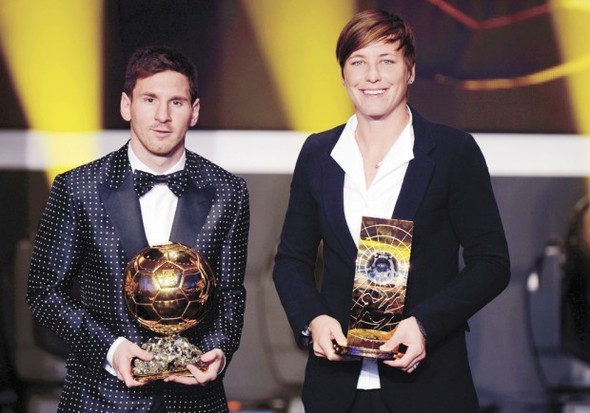 FIFA Player of the Year winners Lionel Messi and Abby Wambach / AP The 2012 FIFA Ballon D'Or and Women's Player of the Year awards were announced yesterday, and Lionel Messi and Abby Wambach took the honors in convincing fashion. Many of the news stories reporting the results, however, such as this and this, failed to show just how clear the consensus was around these two players. The AP article writes that "Messi received 41.60 percent of the points in votes by national team coaches and captains plus selected media. Ronaldo got 23.68 percent and Iniesta 10.91 percent." That makes it sound like Messi only had the support of 40% of voters in what was a straight plurality election. If that were the case, it would make for a very poor voting system, as it would allow for winners that only had the support of a small minority of overall voters. Fortunately, FIFA does not use a simple plurality system. They instead use a weighted Borda Count, where all voters vote for their first, second, and third choices for the male and female players and coaches of the year. First choices get 5 points, second choices 3 points, and third choices one point. Messi received 41.6% of the overall points--which is actually very high, because it is impossible for him to get more than 5 out of the 9 points that each voter was capable of awarding (assuming they listed three players). As ESPN notes, Messi did, in fact, receive a majority of first place votes from all three types of voters: team captains, journalists, and coaches. Many sports use a version of the Borda Count in voting for the best player of that sport's season. Baseball's MVP awards use a system in which voters can vote for 10 players, with their first choice getting 14 points, second choice 9, third choice 8, and so on. In this year's American League voting, triple crown winner Miguel Cabrera soundly defeated Mike Trout with 22 of 28 first place votes, but just 362 of the 1652 total points awarded (22%). College football's Heisman Trophy is also awarded by Borda Count, with a first place vote getting three points, second place getting two points, and third place getting one point. 2012 Heisman winner Johnny Manzel similarly won a majority of first place votes but a plurality of overall "points." Of course, it's possible to win a Borda Count vote without getting the most first place votes. That result would mean that the victorious player had a broad base of support among many voters, rather than just the ardent support of a few. Either way, when a Borda Count system is used, the percentage of total points is essentially meaningless without full data of how many first, second, and third place votes each player received. News coverage of Borda Count results should accurately portray how the election was conducted--as they usually do in MVP and Heisman voting.
By Devin McCarthy 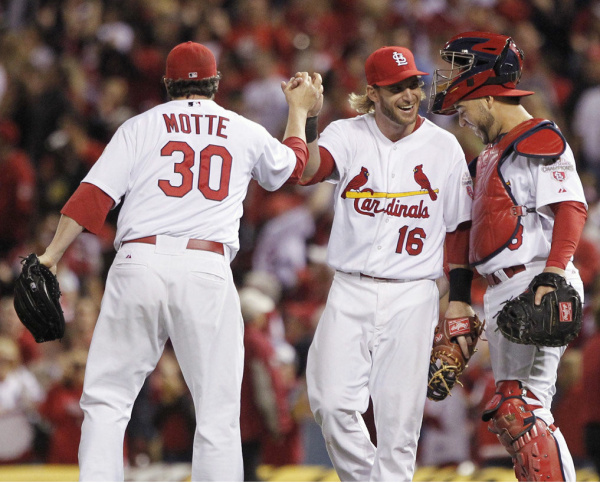 The Cardinals celebrate clinching the second wild card spot, despite finishing a full 6 games behind the Braves, the other wild card team. (SARAH CONARD | REUTERS) With the end of the 2012 Major League Baseball regular season, Commissioner Bud Selig’s new double wild card rule is going into effect for the first time. Unfortunately, the change is not a positive one for baseball. It will do little to make the baseball season more exciting, and it will significantly increase the chances of an unfair finish to the season. In the previous system, the three division winners in each league would all make the postseason, along with a fourth “wild card” team--the division loser with the best record in each league. That set up a simple eight-team, three-round tournament. In the new format, each league now has two wild card teams. But rather than going straight to the Division Series as the division winners do, the wild card teams play a one-game playoff against each other to determine who continues on to the divisional round of the playoffs. Any structural change to the baseball playoffs must do at least one of two things: improve the excitement or fairness of September and October baseball. Put simply, excitement is a combination of how many teams are playing meaningful games at the end of the season and how important those games are to the teams involved. Fairness is the extent to which teams are justly rewarded for their performance in the regular season by increasing their chances of winning a postseason championship. There is inherent unfairness in the postseason, which was famously called a “crapshoot” by Oakland A’s general manager and Moneyball-subject Billy Beane. The playoffs and World Series, by their very nature as short series, make it fairly easy for an inferior team to beat a superior team. As I described when comparing the World Series and the Electoral College, the larger sample size of the regular season is a far better representation of the true quality of a team than the results of any given postseason series. But the playoffs are exciting and a crucial part of baseball’s fan appeal, and a season that ended on October 3 would be pretty boring. Any good postseason model must find a happy medium between excitement and fairness. The new wild card system is designed to add some extra excitement to September races. By adding an extra wild card, creating a single elimination wild card game, and increasing the incentive for teams to win their divisions, Bud Selig hoped to both involve more teams later in the season and make late-season games more meaningful for the best teams. As the following investigation of all possible late-season scenarios shows, however, the new wild card system makes things less exciting almost as often as it creates more drama. Worse, any excitement benefits the system does provide come at a significant cost in fairness. As Joe Posnanski recently noted in his evaluation of the double wild card, sports leagues tend to modify their structures to address the perceived problems of the previous year without looking at the bigger picture. In order to avoid this trap, I will attempt to evaluate both the new and old system in terms of excitement and fairness for all of the end-of-season scenarios that have occurred since the introduction of the wild card in 1995. Postseason Scenarios in the Double Wild Card EraIn this analysis, all teams discussed will be in playoff contention. I’ve set the cutoff for teams being of roughly equal quality and in a "close and exciting race" at a difference of no more than two games at the end of a season. I’m using the old division system as a baseline for fairness, although that system clearly had some unfairness built into it--because division winners often have worse records than second or third place finishers in other divisions, the division system allows teams with worse records to make the playoffs ahead of teams with better records. The effects of the new system on this problem are described in Scenario 4; for the most part, the difference is negligible.
Listed below are the four general types of playoff pictures that occur at the end of baseball seasons (with a few subcategories). Each is examined in terms of how exciting and fair fall baseball would be under both the old and new systems. Scenario 1—Two Equal Wild Cards: The three division leaders easily win their divisions. There are two teams that do not win their divisions but are clearly better than all other non-winners. (ex. 2011 American League) Old System: Exciting and fair. The three best teams will likely make the postseason and there will be an exciting race for the wild card between the two other teams. In 2011 this situation led to one of the all-time great finishes to a season, as the Rays came back to beat out the Red Sox for the wild card spot on the last day of the season. New System: Less exciting, equally fair. All the best teams would still make the postseason. There would be no race for the wild card during the season, as it would be a foregone conclusion that the Rays and Red Sox would play each other in a single wild card game, which would be exciting but not as dramatic as a September-long race. Scenario 1.1 – More Than Two Equal Wild Cards: Same as Scenario 1, but there are three (or more) non-division winners of equal quality competing for the wild card. In that case, the two systems are similarly exciting—in the old system it would be three teams competing for one spot and in the new system three teams would compete for two spots, the winners of which would then play each other in the play-in game. Scenario 2 – Unequal Wild Cards: There is a wild card team that is almost at the level of the three division winners and is clearly better than all other non-winners. There might be some competition for the second wild card spot. (ex. 2012 National League) Old system: Not exciting, but fair. The playoff participants would be decided early in September—this year in the NL, those teams would have been the Nationals, Braves, Reds, and Giants. It wouldn’t have mattered much whether the Braves or Nationals won the NL East. New system: More exciting, but much less fair. The competition for the second wild card spot could be exciting, though one of the teams competing would be mediocre. A possible competition for a division victory could also be more exciting because of the incentive to escape the wild card game. The wild card play-in game would be more exciting than a playoff slate that was decided early on. However, the new system makes the playoffs much less fair, as it puts the second wild card on equal footing with the first wild card despite the difference in their records. This year, the Cardinals will have a chance to beat the Braves in a one game playoff and potentially win the World Series despite having a significantly worse season than the Braves, trailing them by six games at the end of the season. Scenario 2.1 – Four Frontrunning Teams, One or More Weak Division Winners: Same as Scenario 2, except one of the divisions is worse than the wild card team and is competitive. In the new system, the added excitement of the play-in is mitigated by the fact that teams in the worse division still have a chance to make the playoffs via the play-in game even if they lose the division. Under the old system, winning that division would have been all-or-nothing for the teams involved. It is also considerably less fair than the old system because it puts the best wild card team on equal footing with the far-inferior loser of the bad division. (ex. 2009 AL) Scenario 3 – Four Equal Teams in Two Divisions: There are four teams in two divisions (two in each) of roughly equal quality. The teams that don’t win those divisions will compete for the wild card. The winner of the third division is a foregone conclusion, and may be much worse or much better than all the other competing teams. (ex. 2012 AL) Old System: Exciting and fair. The four teams would be competing for three spots. It wouldn’t matter much who won the divisions—but whoever finished last of the four teams would be eliminated. New system: Equally exciting, equally fair. The only difference is that the division championships matter more because teams want to avoid the play-in game. However, that is balanced out by the fact that all four teams will be playing at least one game of playoff baseball no matter what, so there’s little danger of in-season elimination. This year, for instance, the Yankees, Orioles, Rangers, and A’s all made the playoffs. The only question was which two of those four teams would participate in the wild card game. The A’s late surge past the Rangers was dramatic because they avoided that statistical coin flip. At the same time, the Orioles and the Rangers did not have to worry about beating each other, since they would both play in the wild card game regardless. Scenario 3.1 – Three Equal Teams in Two Divisions: The winners of two divisions are foregone conclusions. There are three teams of roughly equal quality, two in the not-yet-decided division and one in another division, battling for the remaining playoff spots. (ex. 2010 NL) Old system: Exciting and fair. The three teams are fighting for the last two spots. Whoever finishes with the worst record among those teams will not make the playoffs. New system: Less exciting and equally fair. All three teams are going to make the playoffs in some form. There will be some excitement in determining who wins the one division in contention, but no excitement for the third team until the wild card play-in game. Scenario 3.2 – Even More Equal Teams: A fifth (or sixth, or more) team is added that is roughly equal in quality to the other four teams. Alternatively, the third division could also have two teams that are equal in quality to those in the other two divisions. Either way, a scenario like this will be very exciting and basically fair under either system. Scenario 4 – A Particularly Weak Division Winner: There are two or more teams that lose divisions, but have a better record than the winner of another division. This scenario can overlap with any of the above scenarios, and thus is independent of the rest. Old System: Unfair. With only one wild card, it is easily possible for a team that misses the playoffs to have a better record than a team that makes the playoffs. New System: Equally unfair. The addition of another wild card makes it less likely that a team with a better record than a division winner will not participate at all in the postseason. However, it also makes it about half as likely that the first wild card will make it to the Division Series—which the division winner is guaranteed to do—since it has to participate in the play-in game. The fairness increase and decrease as a result of the new system roughly balances out. --- In none of these scenarios is the new system obviously superior. There is only one case in which the double wild card is either more exciting or fairer: Scenario 2. But even that manufactured excitement comes at the price of a lot of fairness. Though Scenario 2 is common, it does not make up the majority of cases. Below is a chart showing the outcomes of each season in the wild card era, organized by the scenarios listed above. Scenario 2 is the most common, occurring in 42% of league outcomes in the wild card era. Under the old single-wild card system it was the only scenario that was not exciting—that is, in which there were no competitive races at the end of the season. Under the new system, that scenario can be more exciting, but only in a way that increases unfairness. The double wild card completely disregards any difference in the two wild card teams’ regular season performances, and allows for the possibility of a very good first wild card team being quickly eliminated in the “coin flip” of a play-in game.
Scenario 2.1 adds that same unfairness without adding excitement, as the division race in a worse division will be rendered less exciting by the existence of a second wild card.
Meanwhile, Scenarios 1 and 4 are less exciting under the new system because races that would previously have persisted throughout September are now reduced to a single game.
I will now clumsily combine the numbers in the above chart, assuming that all the mentioned increases and decreases in excitement and fairness are about equal, to give a rough idea of the effects of the new system.
Increased excitement: 15 cases (Scenario 2)
Decreased excitement: 13 cases (Scenario 1+4)
Increased fairness: 0 cases
Decreased fairness: 20 cases (Scenario 2 + Scenario 2.1)
A Better Baseball Season
The takeaway is this: there is no obvious overall increase in the chances of an exciting finish to a baseball season under the new double wild card system. There is, however, a clear increase in the likelihood of a less fair result to the baseball season.
The old wild card system was not perfect either, of course. I am personally in favor of scrapping divisions altogether, since they needlessly create unfairness. Not only do they allow teams with worse records to get to the playoffs ahead of better ones, but they give some teams much easier schedules than others because teams play divisional rivals more often.
I would prefer a simple system in which the four teams in each league with the best records always make the playoffs. There would still be plenty of regular season excitement as teams jockeyed for the last playoff positions, or even all four positions, as would have been the case in the AL this year. It would be very fair--the distortion created by playing in a stronger or weaker division would be eliminated, and the concept of a "wild card" would be unnecessary.
Even if the divisions are here to stay, though, the new double wild card system doesn’t have to be. There is no scenario in which it is a definite improvement, and several scenarios in which it is patently worse.
Try again, Bud.
By Rob Richie
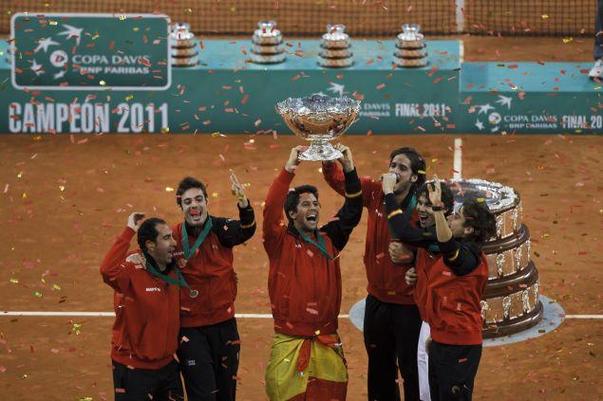
Spain wins last year's Davis Cup / The Hindu
Tennis is a terrific sport, but it needs a real “season” – one that fosters more chances for the top players to play one another and has a clear off-season to avoid burnout for fans and players.
Here’s my proposal. It will give the sport of tennis a more coherent structure, a definitive off-season, and a season-ending Davis Cup extravaganza, and make the sport more fun and more fair in the process.
A Season From February to October: Right now, tennis at best has a six-week off-season, ending with the November round robin tournaments among the top eight players and starting in January with the Australian Open and tune-up events. Far better would be a season that gives players a few months to recharge – playing charity events, if they want, but with no obligations.
I would move the Australian Open schedule up a month into February and close the individual season with the U.S. Open, which would be pushed back to the end of September. The year would close with the two weeks associated with the re-organized Davis Cup.
Fourteen Core Tournaments for the Top 50 Players: There should be 14 tournaments in which the top 50-ranked players at the start of the year would be expected to participate, with additional slots for qualifiers and lower-ranked players who do well in the initial Grand Slams. These 14 tournaments would be the only way to earn points affecting one’s position in the top 50 at the end of the year. The four Grand Slams would count the most, of course, but the other 11 tournaments would provide significant points towards rankings as well. The Slams would have fields of 128 players playing over two weeks; the ten additional tournaments would have 64 players playing over one week.
Tennis Divisions: There would a series of tennis tours analogous to the series of divisions in English Premier League soccer: a First Division composed of the top 50 ranked players, a Second Division of players in the next 50 spots, and so on. A Top 50 player might play in a lower division tournament to improve their play or participate in a favorite locale, but doing so would not provide points affecting the top 50 rankings.
Just as with the English Premier League, at the end of the year the bottom 15 players in the top-50 would be relegated to the Second Division at the start the year and the top 15 in the lower division would be elevated. Grand Slams and other First Division tournaments would provide a chance for a lower division player to jump into guaranteed slots in the higher division during the course of a year.
The 10 non-Slam tournaments would vary in their venue, although well-known venues like the Italian Open and Key Biscayne would always have a Division One tournament at least once every two years. When not holding a Division One tournament, a venue would have a Division Two or Division Three tournament.
Season-Ending Davis Cup: The individual season would end with the U.S. Open in late September -- a much more fitting place to finish the season and determine the top players for the year than a November tournament indoors. In October, the season would end with a two-week Davis Cup in which the top eight nations would gather in one spot – not the same place every year, of course, although the previous year’s winner could potentially earn the option to host the Cup.
Players would participate in as many as six meaningful matches over the two weeks. Each match between nations would continue to be comprised of four singles matches and one doubles match. It would be a single-elimination tournament among the nations, with three wins giving you the Cup. After each three-day match, there would be a day or two of rest before the next round.
Nations would play not only to win the Cup, but to determine their place in the top eight. For example, the four national teams that lost in the first round would have matches to identify which teams finish fifth, and the two losing nations in the second round would play for third. For an incentive, the top five nations might have an automatic bid into next year’s Davis Cup, with the remaining three having to join other nations in a separate qualifying tournament earlier in the year. (To gain entrance into that qualifying tournament, a “Second Division” Davis Cup tournament could take place at the same time as the First Division Cup).
This Davis Cup plan ideally would draw media and fan attention analogous to the Ryder Cup and make the Davis Cup more attractive to players wary of all the extra travel associated with the current Cup.
|

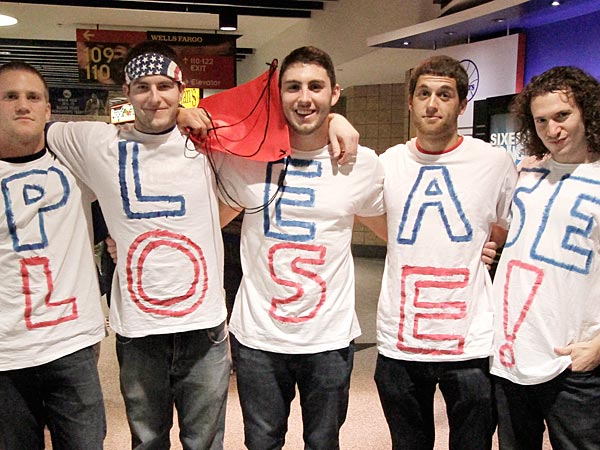
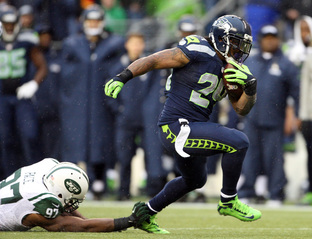
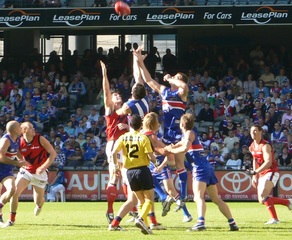
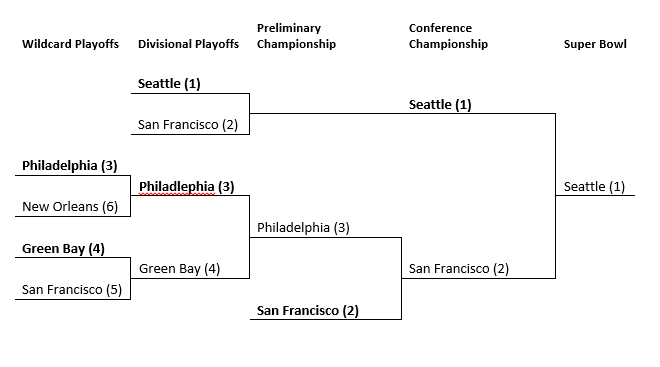

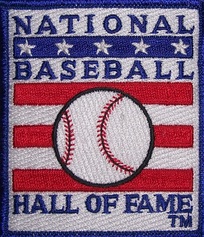





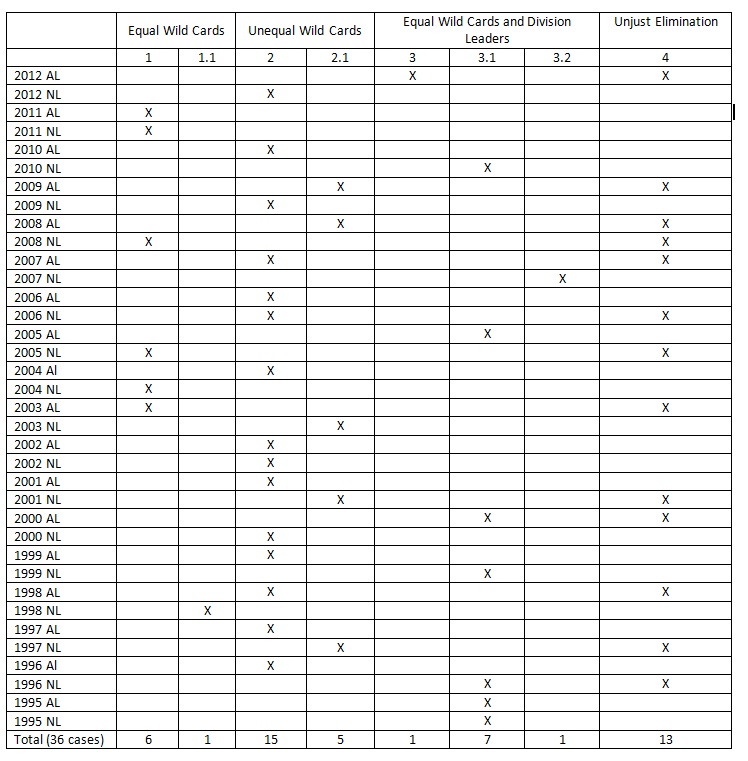

 RSS Feed
RSS Feed